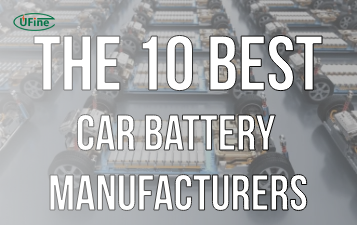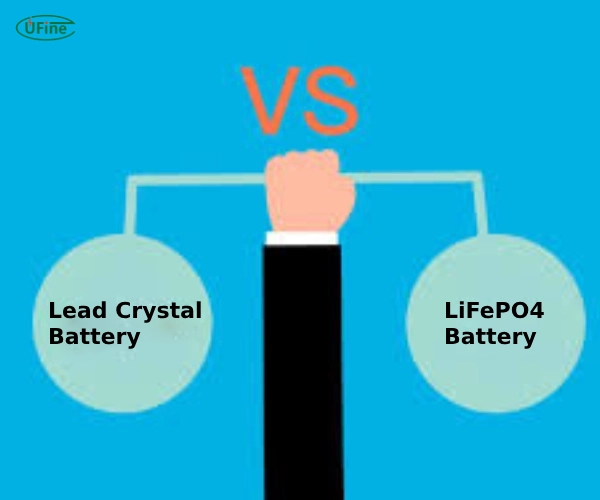What makes Lead Crystal Battery different from LiFePO4? Lead Crystal Battery technology will be explained, including its features, advantages, and typical uses. Then, we’ll delve into LiFePO4 Battery technology, uncovering its characteristics, benefits, and typical applications. Finally, we’ll compare these two types of batteries to determine which might be the better choice for your needs.
Part 1. Lead crystal battery
Lead crystal batteries utilize lead oxide as the positive electrode, lead as the negative electrode and a sulfuric acid electrolyte. This technology differs from traditional lead-acid batteries by incorporating a unique crystalline structure in the lead sulfate compounds during charging and discharging cycles.
Characteristics and Advantages:
- Longevity: Lead crystal batteries boast an extended lifespan compared to conventional lead-acid batteries, with some models offering up to 20 years of service life.
- High Efficiency: These batteries exhibit high charge acceptance and low self-discharge rates, making them efficient energy storage solutions.
- Wide Operating Temperature Range: Lead crystal batteries can operate in extreme temperatures, ranging from -40°C to 65°C (-40°F to 149°F), making them suitable for various environments.
- Environmentally Friendly: Lead crystal batteries are non-toxic and non-hazardous, posing minimal environmental risk during production, use, and disposal.
Applications and Common Uses:
- Renewable Energy Storage: Lead crystal batteries are commonly used in off-grid solar power systems and wind farms to store excess energy generated during peak production.
- Telecommunications: Due to their reliability and long lifespan, lead crystal batteries are utilized in telecommunications infrastructure, providing backup power during outages.
- UPS Systems: Uninterruptible Power Supply (UPS) systems in critical facilities such as hospitals, data centers, and emergency response centers often rely on lead crystal batteries to ensure continuous power supply during emergencies.
Limitations and Drawbacks:
- Cost: Lead crystal batteries typically have a higher initial cost than traditional lead-acid batteries, although the long-term savings from their extended lifespan can offset this expense.
- Weight: These batteries are heavier than some alternative energy storage solutions, which may limit their suitability for specific applications where weight is a concern.
- Limited Availability: Lead crystal batteries may not be as readily available as more common battery types, requiring specialized suppliers or distributors in some regions.
- Charging Voltage Requirements: Lead crystal batteries may require specific charging voltages and protocols, necessitating compatible charging equipment.
- Sulfation Issues: Improper charging or prolonged storage at low charge levels can lead to sulfation, reducing battery performance and lifespan.
Part 2. LiFePO4 battery
LiFePO4 (Lithium Iron Phosphate) batteries belong to the family of lithium-ion batteries. They feature a cathode made of lithium iron phosphate and an anode made of carbon. Compared to other lithium-ion battery chemistries, LiFePO4 batteries offer enhanced safety and stability due to their robust chemical structure.
Characteristics and Advantages:
- Safety: LiFePO4 batteries are inherently safer than other lithium-ion batteries due to their stable chemistry, reducing the risk of thermal runaway and fire hazards.
- Long Cycle Life: These batteries can endure many charge and discharge cycles, typically exceeding 2000 cycles, making them ideal for long-term use.
- High Power Density: LiFePO4 batteries boast a high power density, allowing for rapid charging and discharging rates without compromising performance.
- Wide Temperature Range: LiFePO4 batteries can operate effectively in a broad temperature range, from -20°C to 60°C (-4°F to 140°F), making them suitable for diverse environments and applications.
Applications and Common Uses:
- Electric Vehicles (EVs): People commonly use LiFePO4 batteries in electric vehicles due to their high energy density, long cycle life, and safety features.
- Renewable Energy Storage: These batteries serve as reliable energy storage solutions for solar and wind power systems, providing backup power during periods of low energy production.
- Portable Electronics: LiFePO4 batteries power a wide range of portable electronics, such as laptops, smartphones, and digital cameras, offering long-lasting performance.
- Marine and RV Applications: LiFePO4 batteries are popular for marine vessels and recreational vehicles (RVs) due to their durability, high energy density, and ability to withstand harsh environmental conditions.
Limitations and Drawbacks:
- Cost: LiFePO4 batteries have a higher upfront cost than other lithium-ion batteries. However, the long-term savings from their extended lifespan may offset this expense.
- Weight: These batteries are heavier than some alternative energy storage solutions, which may limit their use in applications where weight is a concern.
- Voltage: LiFePO4 batteries have a lower nominal voltage than other lithium-ion batteries, requiring additional cells to achieve the desired voltage for specific applications.
Part 3. Comparison of lead crystal battery and LiFePO4
Energy Density:
- Lead Crystal Battery: Moderate energy density, typically lower than LiFePO4 batteries.
- LiFePO4 Battery: Higher energy density than lead crystal batteries, allowing for more energy storage in a smaller footprint.
Cycle Life:
- Lead Crystal Battery: Offers a good cycle life but is generally shorter than LiFePO4 batteries.
- LiFePO4 Battery: Exhibits a longer cycle life, with over 2000 charge-discharge cycles in many cases, making it more durable for long-term use.
Safety:
- Lead Crystal Battery: Generally safe but may pose environmental risks due to the presence of lead.
- LiFePO4 Battery: Known for its excellent safety profile, with minimal risk of thermal runaway or explosion, even under extreme conditions.
Charging Time:
- Lead Crystal Battery: Charging time may vary, typically longer than LiFePO4 batteries.
- LiFePO4 Battery: Supports rapid charging capabilities, allowing quicker energy replenishment than lead crystal batteries.
Environmental Impact:
- Lead Crystal Battery: Contains lead, which can have environmental implications if not properly recycled or disposed of.
- LiFePO4 Battery: More environmentally friendly compared to lead crystal batteries, as it does not contain toxic materials like lead.
Cost:
- Lead Crystal Battery: Consider factoring in the long-term savings from extended lifespan, not just the initial cost, compared to LiFePO4 batteries.
- LiFePO4 Battery: Generally, it has a higher initial cost than lead crystal batteries but offers better performance and longevity in the long run.
Applications:
- Lead Crystal Battery: Suitable for applications where moderate energy storage and durability are required, such as off-grid solar power systems and telecommunications.
- LiFePO4 Battery: Ideal for applications requiring high energy density, long cycle life, and superior safety, including electric vehicles, renewable energy storage, and portable electronics.
Part 4. FAQs
-
What is the lifespan of a lead crystal battery?
Lead crystal batteries typically offer an extended lifespan compared to traditional lead-acid batteries, with some models lasting up to 20 years with proper maintenance. -
Are lead crystal batteries environmentally friendly?
While lead crystal batteries are non-toxic and non-hazardous, they still contain lead, which can have environmental implications if not properly recycled or disposed of. However, companies and organizations are trying to improve their eco-friendliness through recycling programs. -
Are LiFePO4 batteries safe to use?
Yes, LiFePO4 batteries are known for their excellent safety profile, with minimal risk of thermal runaway or explosion, even under extreme conditions. This makes them suitable for various applications, including electric vehicles and renewable energy storage systems. -
How do the charging times of lead crystal batteries and LiFePO4 batteries compare?
LiFePO4 batteries generally support rapid charging capabilities, allowing for quicker energy replenishment than lead crystal batteries, which may have longer charging times depending on the specific model and charging conditions.
Related Tags:
More Articles

The 10 Best Car Battery Manufacturers: A Complete Guide
Looking for the best car battery brands in 2025? Discover the top 10 manufacturers known for performance, safety, and innovation.
What Is a VRLA Battery and Why Are Many Users Upgrading to Lithium?
VRLA batteries are sealed lead-acid types, but many now switch to lithium for better lifespan, efficiency, and weight in modern power systems.
What Type of Battery Does the AirPods Battery Use?
Learn everything about AirPods battery types, quality parameters, customization needs, and essential tips to improve battery performance.
Can You Replace a VRLA Battery with Lithium? What You Need to Know
You can replace a VRLA battery with lithium. Learn key differences, pros, and tips for a safe, efficient upgrade in your power setup.
Can a Lithium Battery Be Heavy Duty? What Makes It Different
Lithium batteries can be heavy-duty. Learn how they meet challenging demands and why they're a top choice for modern power needs.




